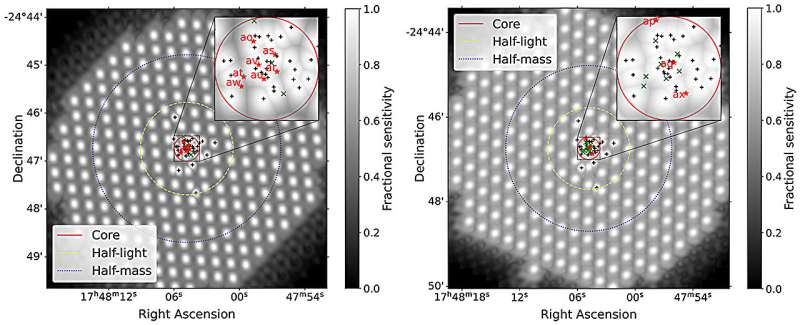This article has been reviewed according to Science X's editorial process and policies. Editors have highlighted the following attributes while ensuring the content's credibility:
fact-checked
peer-reviewed publication
trusted source
proofread
Telescope tag-team discovers 10 strange and exotic pulsars

Towards the center of our Milky Way galaxy, in the constellation Sagittarius, astronomers have discovered 10 monstrous neutron stars. These particular stars, called pulsars, reside together in globular cluster Terzan 5, a crowded home for hundreds of thousands of different types of stars.
The paper is published in the journal Astronomy & Astrophysics.
Pulsars are millions (or even billions) of times more dense than other stars and rotate rapidly, emitting bright pulses of light from their strong magnetic fields, making them a beacon for astronomers to find. In one of the most jam-packed places in our Milky Way, many pulsars in Terzan 5 have evolved into bizarre and eccentric forms.
Astronomers already knew that 39 pulsars call Terzan 5 home. With the teamwork of the U.S. National Science Foundation Green Bank Telescope (NSF GBT) and the South African Radio Astronomy Observatory's MeerKAT Telescope, 10 more have been added to the count.
"It's very unusual to find exotic new pulsars. But what's really exciting is the wide variety of such weirdos in a single cluster," shared Scott Ransom, a scientist with the U.S. National Science Foundation National Radio Astronomy Observatory (NSF NRAO). The discoveries were made by an international team of astronomers from NSF NRAO, the Max Planck Institute for Gravitational Physics (Albert Einstein Institute) (AEI), and the Max Planck Institute for Radio Astronomy.
The Meerkat Telescope was able to determine the rough location of each pulsar by tracking and timing how quickly they rotate, matched against twenty years of Terzan 5 observations taken by the NSF GBT, which revealed the bizarre and eccentric details of these stars.

"Without the NSF Green Bank Telescope's archive, we wouldn't have been able to characterize these pulsars and understand their astrophysics," adds Ransom. The archival NSF GBT data allowed astronomers to pinpoint the pulsars' position on the sky, measure their specific movements, and see how their orbits changed over time.
Among the discoveries, astronomers saw two likely neutron stars pulled into each other's orbit as a binary system. Out of 3,600 known pulsars in the galaxy, only 20 have been identified as double neutron-star binaries.
When pulsars pair off in binaries, the gravitational pull from one to the other can steal material and energy, causing one to spin even faster, becoming a millisecond pulsar. This pair could be a record breaker, with a new contender for fastest spinning pulsar in a double neutron-star system, and the longest orbit of its kind. The current record holder for fastest spinning pulsar already resides in Terzan 5. Only future observations will reveal the truth.
Astronomers also observed three new rare pulsar "spider" binary systems (in addition to five already known in the cluster) called Redbacks or Black Widows, depending on the types of companion stars that they have. A companion star falls into the orbit of a spider pulsar, where a web of plasma fills the space between the two (caused by outflows from the companion star due to the pulsar's energy) slowly dissolving the companion over time.
The discovery of these strange pulsars allows scientists to better understand globular clusters, neutron stars, and even test Einstein's theory of general relativity, along with expanding what is known about pulsar categories. The research team is already making plans to find even more in Terzan 5, with the support of volunteers.
Citizen scientists who'd like to share in the excitement of this discovery can help at Einstein@Home. This project, led by scientists at AEI, has already discovered more than 90 new neutron stars.
More information: P. V. Padmanabh et al, Discovery and timing of ten new millisecond pulsars in the globular cluster Terzan 5, Astronomy & Astrophysics (2024). DOI: 10.1051/0004-6361/202449303
Journal information: Astronomy & Astrophysics
Provided by National Radio Astronomy Observatory




















